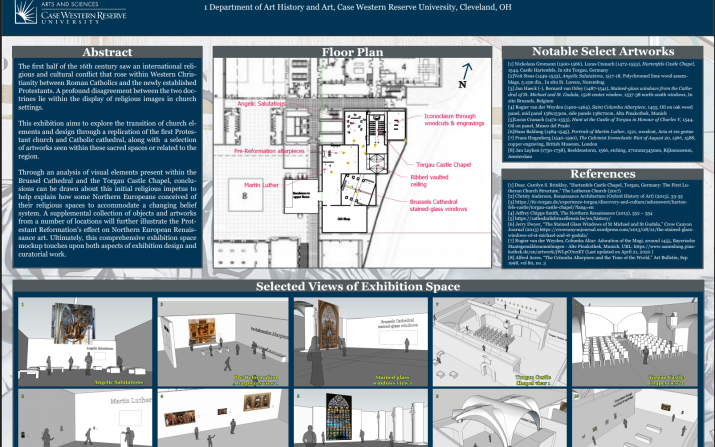Junior's presentation featured with Virtual Intersections

A double major in Art History and Materials Science & Engineering, junior Winston Kam brought his two majors together for a presentation for CWRU’s Virtual Intersections & Celebrations of Student Writing and Research event.
Kam, who is also an English minor, was inspired to participate by his final project in ARTH360: Renaissance Art in Northern Europe taught by Associate Professor Catherine Scallen of the art history department. For his final group project, “Picturing the Reformation,” where each group in the class had five people and each person chose four works of art that illustrated an aspect of the course, “it seemed like a seamless transition to transform my section of our class project into an independent SOURCE project,” said Kam.
While working on his Virtual Intersections project, “The Protestant Reformation and Interior Church Architecture – Art Exhibition,” Kam’s materials courses proved beneficial. One of the four artworks he studied was a hanging sculpture made of lime wood, and it was the first time Kam had seen anything made of lime wood. He did some further research and discovered that because of lime wood’s light weight, it is good for natural and stained finish. Though this particular sculpture was made 500 years ago, it still hangs in St. Lorenz in Nuremberg, Germany. “The materials of the artworks are always an important aspect to regard,” said Kam.
Kam chose to study this sculpture and a pre-reformation altar piece to showcase the elements within churches and the possible impacts of iconoclasm. The other two works he focused on were a Protestant Chapel and a Catholic cathedral to show how the different belief systems in Christianity impact places of worship.
Although Kam considers himself more of an “arts thinker” than an engineer and plans to pursue a career in architecture after he graduates in 2022, he appreciates his STEM background and expects it to benefit him. He particularly enjoyed statics classes. “As I move forward into my career towards architecture, statics principles will come into play every which way.” He also enjoys robotics, designing and making 3D projects with his 3D printer in his spare time. If there are any opportunities in the department for materials research related to art history, he hopes to participate.
Kam was first drawn to materials science and engineering the summer after his junior year of high school, when he completed a research project on soft matter 3D printing under Dr. Thomas Angelini at University of Florida. “We dove into rheological properties and many polymer sciences related concepts,” said Kam. “Seeing materials sciences come to life with real world applications fueled my passion to study that field of engineering in college.”
A native Floridian, Kam most appreciates the network he’s created at CWRU. When he first came to Cleveland, he didn’t know anyone in the area, but now, “I’m happy to say I’ve met and have gotten to know some pretty incredible people along the way who I could count on for anything.” One of the people who particularly stands out is his USSY instructor, Dr. John Wiehl, who he has created a strong bond with during his time at CWRU. “Dr. Wiehl is someone who I can ask any kind of questions, whether it relates to university logistics or life advice. There have just been too many instances where we run into each other and our conversations feel as if we’ve been friends/colleagues for years.” One of Kam’s favorite memories with Wiehl is running into each other in front of a Degas painting at the Museé d’Orsay in Paris, France in summer 2019.
After he graduates from CWRU, Kam hopes to teach high school science or math in the corps with Teach For America. “Educational inequity is an issue that is fundamental to who I am and who I’ve become. I couldn’t see myself averting from their opportunity to teach in a classroom and develop necessary empathy for young students who didn’t get the same luxurious opportunities many of us CWRU students did to get where we are today.” After two years with Teach For America, he plans to start architecture school and hopes to attend a school with opportunities for interdisciplinary studies. His long term goals include starting his own firm to design arts and sciences related buildings, such as museums, performance centers and public libraries.
